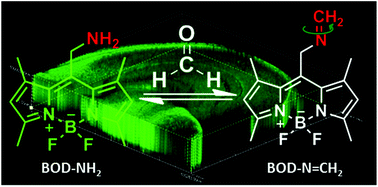Our official English website, www.x-mol.net, welcomes your feedback! (Note: you will need to create a separate account there.)
A reversible fluorescent probe based on CN isomerization for the selective detection of formaldehyde in living cells and in vivo†
Analyst ( IF 4.2 ) Pub Date : 2017-12-01 00:00:00 , DOI: 10.1039/c7an01488k Xinyu Song 1, 2, 3, 4, 5 , Xiaoyue Han 4, 5, 6, 7, 8 , Fabiao Yu 4, 5, 6, 7, 8 , Jinjin Zhang 1, 2, 3, 4, 9 , Lingxin Chen 4, 5, 6, 7, 8 , Changjun Lv 1, 2, 3, 4, 9
Analyst ( IF 4.2 ) Pub Date : 2017-12-01 00:00:00 , DOI: 10.1039/c7an01488k Xinyu Song 1, 2, 3, 4, 5 , Xiaoyue Han 4, 5, 6, 7, 8 , Fabiao Yu 4, 5, 6, 7, 8 , Jinjin Zhang 1, 2, 3, 4, 9 , Lingxin Chen 4, 5, 6, 7, 8 , Changjun Lv 1, 2, 3, 4, 9
Affiliation

|
Formaldehyde (FA) is an endogenously produced reactive carbonyl species (RCS) through biological metabolic processes whose concentration is closely related to human health and disease. Noninvasive and real-time detection of FA concentration in organisms is very important for revealing the physiological and pathological functions of FA. Herein, we design and synthesize a reversible fluorescent probe BOD-NH2 for the detection of FA in living cells and in vivo. The probe is composed of two moieties: the BODIPY fluorophore and the primary amino group response unit. The probe undergoes an intracellular aldimine condensation reaction with FA and forms imine (C![[double bond, length as m-dash]](https://www.rsc.org/images/entities/char_e001.gif) N) which will result in C
N) which will result in C![[double bond, length as m-dash]](https://www.rsc.org/images/entities/char_e001.gif) N isomerization and rotation to turn-off the fluorescence of the probe. It is important that the probe can show a reversible response to FA. The probe BOD-NH2 has been successfully applied for detecting and imaging FA in the cytoplasm of living cells. BOD-NH2 is capable of detecting fluctuations in the levels of endogenous and exogenous FA in different types of living cells. The probe can be used to visualize the FA concentration in fresh hippocampus and the probe can further qualitatively evaluate the FA concentrations in ex vivo-dissected organs. Moreover, BOD-NH2 can also be used for imaging in mice. The above applications make our new probe a potential chemical tool for the study of physiological and pathological functions of FA in cells and in vivo.
N isomerization and rotation to turn-off the fluorescence of the probe. It is important that the probe can show a reversible response to FA. The probe BOD-NH2 has been successfully applied for detecting and imaging FA in the cytoplasm of living cells. BOD-NH2 is capable of detecting fluctuations in the levels of endogenous and exogenous FA in different types of living cells. The probe can be used to visualize the FA concentration in fresh hippocampus and the probe can further qualitatively evaluate the FA concentrations in ex vivo-dissected organs. Moreover, BOD-NH2 can also be used for imaging in mice. The above applications make our new probe a potential chemical tool for the study of physiological and pathological functions of FA in cells and in vivo.
中文翻译:

基于C![[双键,长度为m-破折号]](https://www.rsc.org/images/entities/char_e001.gif) N异构化的可逆荧光探针,用于选择性检测活细胞和体内的甲醛†
N异构化的可逆荧光探针,用于选择性检测活细胞和体内的甲醛†
甲醛(FA)是通过生物代谢过程内生产生的反应性羰基物质(RCS),其浓度与人类健康和疾病密切相关。生物中FA浓度的无创实时检测对于揭示FA的生理和病理功能非常重要。本文中,我们设计并合成了可逆荧光探针BOD-NH 2,用于检测活细胞和体内的FA 。该探针由两个部分组成:BODIPY荧光团和伯氨基响应单元。探针与FA发生细胞内醛亚胺缩合反应并形成亚胺(C![[双键,长度为m-破折号]](https://www.rsc.org/images/entities/char_e001.gif) N),这将导致C
N),这将导致C![[双键,长度为m-破折号]](https://www.rsc.org/images/entities/char_e001.gif) N异构化和旋转以关闭探针的荧光。重要的是,探针应显示出对FA的可逆反应。BOD-NH 2探针已成功应用于活细胞细胞质中FA的检测和成像。BOD-NH 2能够检测不同类型活细胞中内源性和外源性FA水平的波动。该探针可用于可视化新鲜海马中的FA浓度,并且该探针可进一步定性评估离体解剖器官中的FA浓度。此外,BOD-NH 2也可以用于小鼠成像。上述应用使我们的新探针成为研究FA在细胞和体内的生理和病理功能的潜在化学工具。
N异构化和旋转以关闭探针的荧光。重要的是,探针应显示出对FA的可逆反应。BOD-NH 2探针已成功应用于活细胞细胞质中FA的检测和成像。BOD-NH 2能够检测不同类型活细胞中内源性和外源性FA水平的波动。该探针可用于可视化新鲜海马中的FA浓度,并且该探针可进一步定性评估离体解剖器官中的FA浓度。此外,BOD-NH 2也可以用于小鼠成像。上述应用使我们的新探针成为研究FA在细胞和体内的生理和病理功能的潜在化学工具。
更新日期:2017-12-01
![[double bond, length as m-dash]](https://www.rsc.org/images/entities/char_e001.gif) N) which will result in C
N) which will result in C![[double bond, length as m-dash]](https://www.rsc.org/images/entities/char_e001.gif) N isomerization and rotation to turn-off the fluorescence of the probe. It is important that the probe can show a reversible response to FA. The probe BOD-NH2 has been successfully applied for detecting and imaging FA in the cytoplasm of living cells. BOD-NH2 is capable of detecting fluctuations in the levels of endogenous and exogenous FA in different types of living cells. The probe can be used to visualize the FA concentration in fresh hippocampus and the probe can further qualitatively evaluate the FA concentrations in ex vivo-dissected organs. Moreover, BOD-NH2 can also be used for imaging in mice. The above applications make our new probe a potential chemical tool for the study of physiological and pathological functions of FA in cells and in vivo.
N isomerization and rotation to turn-off the fluorescence of the probe. It is important that the probe can show a reversible response to FA. The probe BOD-NH2 has been successfully applied for detecting and imaging FA in the cytoplasm of living cells. BOD-NH2 is capable of detecting fluctuations in the levels of endogenous and exogenous FA in different types of living cells. The probe can be used to visualize the FA concentration in fresh hippocampus and the probe can further qualitatively evaluate the FA concentrations in ex vivo-dissected organs. Moreover, BOD-NH2 can also be used for imaging in mice. The above applications make our new probe a potential chemical tool for the study of physiological and pathological functions of FA in cells and in vivo.
中文翻译:

基于C
![[双键,长度为m-破折号]](https://www.rsc.org/images/entities/char_e001.gif) N异构化的可逆荧光探针,用于选择性检测活细胞和体内的甲醛†
N异构化的可逆荧光探针,用于选择性检测活细胞和体内的甲醛†
甲醛(FA)是通过生物代谢过程内生产生的反应性羰基物质(RCS),其浓度与人类健康和疾病密切相关。生物中FA浓度的无创实时检测对于揭示FA的生理和病理功能非常重要。本文中,我们设计并合成了可逆荧光探针BOD-NH 2,用于检测活细胞和体内的FA 。该探针由两个部分组成:BODIPY荧光团和伯氨基响应单元。探针与FA发生细胞内醛亚胺缩合反应并形成亚胺(C
![[双键,长度为m-破折号]](https://www.rsc.org/images/entities/char_e001.gif) N),这将导致C
N),这将导致C![[双键,长度为m-破折号]](https://www.rsc.org/images/entities/char_e001.gif) N异构化和旋转以关闭探针的荧光。重要的是,探针应显示出对FA的可逆反应。BOD-NH 2探针已成功应用于活细胞细胞质中FA的检测和成像。BOD-NH 2能够检测不同类型活细胞中内源性和外源性FA水平的波动。该探针可用于可视化新鲜海马中的FA浓度,并且该探针可进一步定性评估离体解剖器官中的FA浓度。此外,BOD-NH 2也可以用于小鼠成像。上述应用使我们的新探针成为研究FA在细胞和体内的生理和病理功能的潜在化学工具。
N异构化和旋转以关闭探针的荧光。重要的是,探针应显示出对FA的可逆反应。BOD-NH 2探针已成功应用于活细胞细胞质中FA的检测和成像。BOD-NH 2能够检测不同类型活细胞中内源性和外源性FA水平的波动。该探针可用于可视化新鲜海马中的FA浓度,并且该探针可进一步定性评估离体解剖器官中的FA浓度。此外,BOD-NH 2也可以用于小鼠成像。上述应用使我们的新探针成为研究FA在细胞和体内的生理和病理功能的潜在化学工具。


























 京公网安备 11010802027423号
京公网安备 11010802027423号